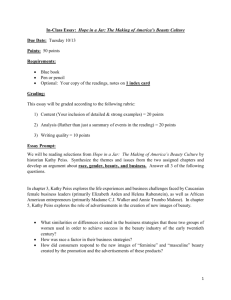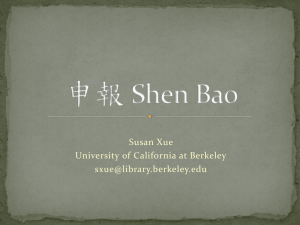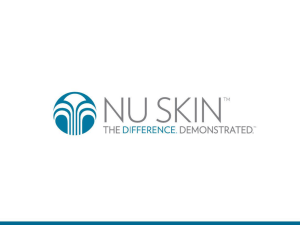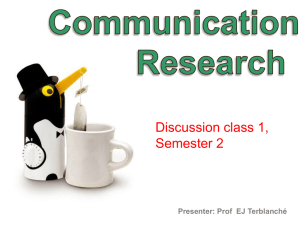File - Shannon Smith My ePortfolio
advertisement
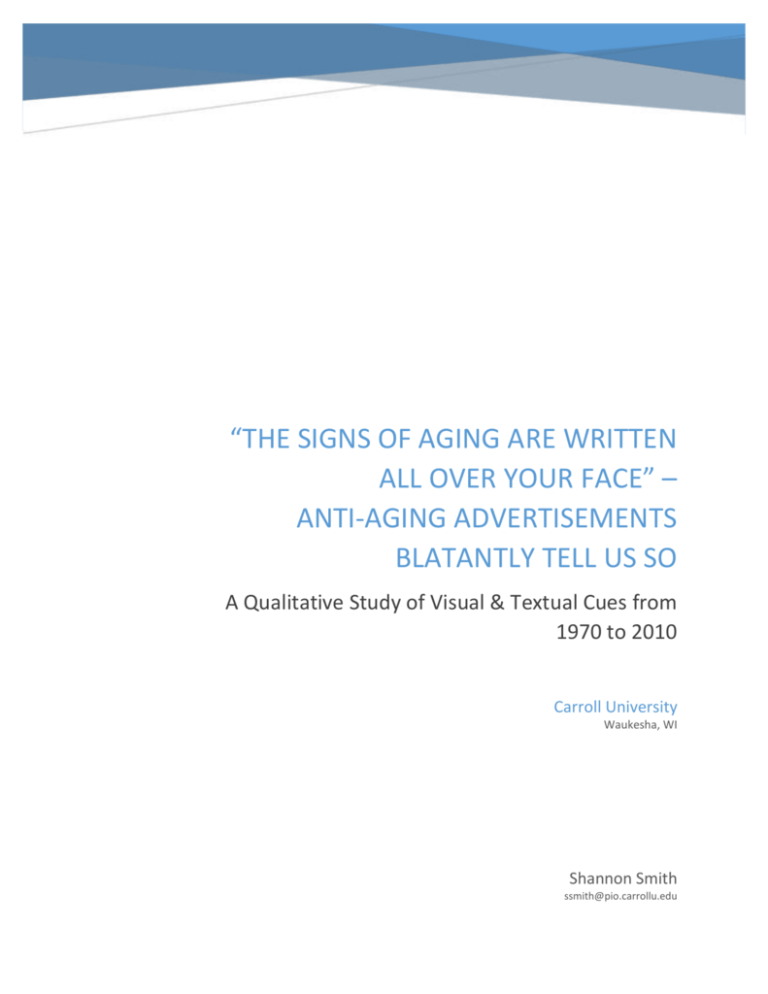
“THE SIGNS OF AGING ARE WRITTEN ALL OVER YOUR FACE” – ANTI-AGING ADVERTISEMENTS BLATANTLY TELL US SO A Qualitative Study of Visual & Textual Cues from 1970 to 2010 Carroll University Waukesha, WI Shannon Smith ssmith@pio.carrollu.edu Abstract Anti-aging products have become a huge market aimed at women who are “maturing” but still “want to look fabulous” (Ganahl, 2002). Global market sales for such products and services was valued at $249.3 billion in 2012 alone (Presswire, 2012). The purpose of this study is to qualitatively analyze 410 pages worth of anti-aging product advertisements offered in three highly known beauty magazines between 1970 and 2010 to determine if the number of ads has increased, the textual cues used to promote the use of such products has gone from subtle to blatant, and if age, ethnicity, and style portrayed in such advertisements have changed. Literature Review Idealized images of beauty and youth are repeatedly transmitted through media to impact women (Bissell & Chung, 2009). Often, models in advertising represent highly idealized images of physical attractiveness, social achievements and physical appearances (Antioco, Smesters, and Le Boedec, 2012). Research in this area is important because self-image affects women’s health and self-image (Morris and Nichols, 2013). Ideal social self-concepts that are presented in advertisements portray desirable characteristics and positively influences consumer usage of advertised products (D’Alessandro and Chitty, 2011). The more women are exposed to media, the more they will believe images, messages, and ideas are real (Bissell and Chung, 2009). According to Census Bureau statistics (2002), there are 38.5 million women over the age of 40 and over the years cosmetic companies and advertisers have become smarter about appealing to baby-boomer women through both the creation and marketing of products targeted specifically to this age group (Butler, Etcoff, Orback, and D’Agostina, 2006). Women of this generation are greatly affected by media and how it connects youth with beauty because they have been immersed, since their late teen years, in a variety of media outlets which consistently 1 communicates beauty expectations and connects loss of beauty to aging (Gosselink, Cox, McClure, and De Jong, 2008). Advertisers strategically attempt to imprint specific images for a brand and how it enhances beauty in the minds of consumers (Morris and Nichols, 2013), creating a “distorted mirror” (Pollay, 1984). This negatively reinforces the connotation of the acceptable appearance for aging woman (LaWare and Moutsatsos, 2013). Women must appear youthful to conform to current cultural beauty standards (Wolf, 2002). According to Coupland (2007), the face contains zones, “which negotiate qualities for social/sexual attraction.” Since the face is the main focal point assessed when judging youthfulness and beauty, older women feel they must, “hide or erase the outward signs of aging such as wrinkles and age spots” to remain attractive (LaWare and Moutsatsos, 2013). Women feel inclined to analyze individual facial areas that are considered flaws. As a result, anti-aging advertisements focus on these insecurities by featuring products meant to target and rectify aging issues affecting specific areas of the face such as eyes, lips, and skin (LaWare and Moutsatsos, 2013). There is also a belief that matching media ideals to a specific culture makes the product more desirable (Thesander, 1997). Sierra, Hyman, and Torres (2009) found that women form self-concepts based on both their social and self-identity. If they perceive themselves as ethnically similar to the model depicted in an advertisement, they are more inclined to have a positive attitude toward the ad. In general, women’s attitudes are a strong influence regarding their purchasing actions (Priester, Dhananjay, Fleming, and Godek, 2004). Durvasula et al., (2001) offer two different thought processes regarding the forces that influence vanity. One process explains vanity as first and foremost a biologically driven personality trait that is influenced by genetic makeup. The other process considers vanity to be social influenced. According to Mason (1981), vanity and the way a woman feels about her 2 appearance is largely influenced by one’s social and economic environment. Often, models in advertising represent highly idealized images of physical attractiveness and social achievements (Antioco et al., 2012; Durvasula and Lysonski, 2001). Empirical evidence supports the idea that Western cultures such as the United States value physical attractiveness more than countries found in Eastern cultures (Schwartz and Bilsky, 1987). Bandura’s (1986, 2001) studies regarding Observational Learning Theory suggest that three cognitive processes, attention, retention, and motivation, apply when analyzing beauty advertising. Advertisements grab our attention when they are simple, useful, and depicted in a positive manner (Bandura, 2001). Relating to visual and textual cues can “expand our repertoire of behavioral options” far beyond what we would discover through our own thought and other learning processes (Griffin, 2012). Retention is the restructuring of acquired information into schema that is stored in memory (Bandura 1994, 2001). According to Bandura (2001), this step is most powerful because we can encode the ambiguous information to make it vital to our selfimage. Motivation is where concepts from memory are connected to action and translated into guides for behavior. This is the driving force behind the reproduction of observationally learned behavior (Bandura, 2001). Motivation to act upon visual and textual cues can be immediate or called upon at a later time, when information learned over an extensive period of time is pulled from within long-term memory and is now at our disposal (Griffin, 2012). While opinions vary regarding exact frequency, women must be exposed to advertisements repeatedly for a message to make an impression that the women will retain and act upon (Kelley, Jugenheimer, and Sheehan, 2012). Women have cultivated socially acceptable images of aging over time and through repeated and frequent viewing of anti-aging advertisements (Van Vonderen and Kinnally, 2012). This process may create stereotypes, which hold negative psychological and 3 sociological affects that represent widely held beliefs and survive over long periods of time (Wells, 1983). The “remedies” offered for a more youthful appearance have become more obvious in the language used in anti-aging product advertisements as time has progressed. Advertising provides images and semantics that are relevant to its target audience while also mindfully considering specific cultural, economic, and social environments (Zhang, Srisupandit, and Cartwright, 2009). Text and images aimed at an older female market portray skin care as a pertinent issue and offer “highly technologized solutions” for treatment of aging skin (Coupland, 2007). H1 The quantity of anti-aging product advertisements found in beauty magazines has increased from 1970 to 2010. H2 Textual cues found in anti-aging product advertisements have become increasingly blatant from 1970 to 2010. RQ1 How have the ages, ethnicities, and beauty types of women portrayed in anti-aging product ads changed from 1970 to 2010? Methods The sample of 330 advertisements, displayed across a total of 410 pages, were taken from three prominent women’s magazines, Cosmopolitan, Vogue, and Glamour that focus on beauty and fashion, include a variety of advertisements. Median readership ages are 31, 33, and 36, respectively (Cosmopolitan, Media Kit, 2013; Glamour, Media Kit, 2013; Vogue, Media Kit, 2013). On average, they reach more than 12 million women readers per month. Two monthly issues, March and September, were selected from 1970 to 2010 in five year intervals (ex. 1970, 1975, 1980, etc.) Substitutions in the following instances were made due to unavailability of specific issues: Vogue - 2005 not available, substituted 2006; Glamour - March 1975 not available, substituted April 1975; Glamour - 1985 not available, substituted 1986; Cosmopolitan 4 – March 1990 not available, substituted April 1990; Cosmopolitan - 1980 not available, substituted 1981. Advertisements qualified for this study if they included any of the words used in a Neutrogena Healthy Skin Anti-Wrinkle Cream advertisement which toted the slogan: The Signs of Aging are Written All Over Your Face (Glamour, 2000). The advertisement offered a close-up image of a woman in her mid-twenties with words used to describe aging printed across various facial features. The expressions, “dull skin, blotchiness and sun damage” are imprinted across her forehead while “lines, roughness, uneven skin tone, dry skin, and wrinkles” are etched along the side of her face, beginning at the eye and ending at her chin. Advertisements also qualified for this study if text or images suggested or stated that a product was intended to, “regain the feeling or appearance of younger looking skin.” Frequency of advertisements placed were documented from 1970 to 2010 to determine whether an increase occurred. A qualitative content analysis identified and evaluated the prevalence of textual cues used in various advertisements that may function as motivating factors for the purchase of anti-aging products by women between 1970 and 2010. Visual coding was performed on anti-aging advertisements that featured a model. Women featured were visually coded for age (20 or younger, 21-30, 31-40, 41-50, 51-60, and 60+), ethnicity (Caucasian, Black, Hispanic, Asian, Other), and portrayal of beauty type (Classic/Feminine, Cute, Trendy, Casual, Other; Chan and Cheng, 2012) to determine whether these specific qualities have changed from 1970 to 2010 (Appendix A). 5 Results/Analysis Specifically, two hypothesis and one question guided this research: (a) I speculated that the number of anti-aging advertisements increased from 1970 to 2010, (b) I speculated that the text used in anti-aging advertisement has become more blatant, and (c) I questioned whether the age, ethnicity, and portrayal of beauty type for women featured in anti-aging advertisements has changed from 1970 to 2010. Number of anti-aging advertisements Table 1 Year 1970’s 1980’s 1990’s 2000’s 2010 (so far) 2010s (speculated) No. of Anti-aging Advertisements 43 85 77 76 49 98 No. of Pages of Anti-aging Advertisements 52 102.5 99 99.25 58 116 Table 1 represents the number of anti-aging advertisements as well as the number of pages that said advertisements were displayed on in Cosmopolitan, Glamour, and Vogue in each decade as listed. The numbers accumulated for 2010 were only for advertisements found in said year and cannot include 2015 advertisements (as is the case in the other respective totals), so I speculated that advertisements and advertisement pages for the 2010 decade would be double those found in the year 2010. This trend proved to be the case in three out of four decades researched (1970, 1980, and 2000). The 1990s saw a decrease in advertisements by three from 1990 to 1995. 6 Textual analysis 1970 Youth is a term that can be found in ads from the beginning of my research and offers a positive connotation between the use of anti-aging products and looking younger and “full of life”. Fifty-two pages worth of advertisements used phrases such as: “smart, good girl”, “brings out ‘fresh, country air look’ in complexion”, and “retain a youthful glow” as motivation to purchase and use products. This method of advertising subtly reinforces the idea that self-image is tied to physical appearance. Language used to describe the “signs of aging” is minimal in anti-aging advertisements at this point. Skin dryness and roughness are the main skin issues mentioned at this point and suggestions for treatment is offered by featured products that “offer moisture to silken and soften your skin” and create a more youthful appearance. 1980 While youth is still the prevalent term used to describe how a women will feel after using a product, prevention plays an important role in skin treatment in this decade. “Prevent wrinkles from showing too soon”, “Works against aging of skin”, “Protect against aging”, “Keep skin from looking old” are some of the textual cues spread over 102 pages of advertisements. Urgency (1985) joins in with “Help is in sight”, “Come to the rescue”, and “No skin can afford to be without it”. Demonstrating a sense of need that is immediate may not create an attitude regarding a product, but it can reinforce one that is already there. Ages are now mentioned in advertisements, (1985) offering advice on specific skin regiments that should be followed as early as your twenties to prevent the appearance of aging. 7 Age as a concept is also enforced, “never too soon to start” and “betray your biological age” suggest that product must be started early for best results. While skin dryness and roughness received subtle mention during the 70’s, their attention increases and is accompanied by “lines around the mouth and eyes.” Skin dryness is still noted as the culprit for skin roughness, but in the 80’s it is also blamed for “the little lines around the eyes and mouth”. Language created to label “signs of aging” rapidly increases during this decade. Skin dryness, roughness, and lines “around the eyes and mouth” are joined by other labeled skin imperfections such as sun damage, dullness, blotchiness, uneven skin tone, and wrinkles. By 1985 my study found that three other terms were added to this list: reduction in firmness, puffiness under the eyes, and dark under eye circles. Identifying specific skin changes, relating them to aging in a negative way, and implying that urgency to prevent and eliminate the issues is necessary serves to reinforce the social attitude that women must maintain a youthful appearance. 1990 Repair and defy age are the central themes stacked on top of those introduced and reinforced in the 70’s and 80’s. Phrases such as, “Grow old gracefully, WHY”, “Defies challenge of time”, “Age is a fact of life, but why look at it?”, and “Keep [youth] as long as you can” dominate 99 pages worth of anti-aging advertisement text. Use of the term repair insinuates that damage has been done to the skin’s surface that must be fixed while defy implies that aging is not a natural process for women and any signs that might be produced because of it must be eliminated. Reasons for aging such as, “Stress”, “Fatigue”, Worn out cells”, and “Sun, wind, and pollution” are also included in advertisements of this decade. These phrases are used to explain 8 that while women may take good care of their bodies, signs of anti-aging cannot always be helped because we are victims of uncontrollable outside forces. Hence, the product will always be necessary. Results (1995) is yet another key theme added during this decade. Statements such as, “instant results”, “see changes in skin in one day”, and “see visible results in just four weeks”. Such statements allow the woman user to believe in instant gratification along with the idea that consistent and continual use will create the much desired results. While the 90’s does not see an increase in the usage of age defining language (wrinkles, dry skin, dull skin, blotchiness, roughness, etc), advertisements are no longer subtle in directing women towards use of anti-aging products. The product names now include a specific “problem” which it is designed to “solve.” For instance, Stress Cream by Almay, “offers treatment for dry lines, relief from tired skin, radiance, and renewed glow” (Glamour, 1990). While earlier advertisements allowed the reader to interpret how the product was useful, advertisements of this decade take on a dominating style of communication with the viewer. Language is direct when explaining what is best for the product user, “Eyes look best when the skin looks firm and smooth – unworried by lines, sags, and puffs” (Glamour, 1990). Descriptions are no longer illusive, they are blatantly obvious and no mistake can be made while interpreting the needs fulfilled by product featured in the advertisement. 2000 The first decade of the new century provided 99 ¼ pages filled with anti-aging advertisements and two new themes were added to those lingering and insistent ideas from the 70’s, 80’s, and 90’s. Drastic measures is the unashamed phrase used in the first decade of 2000. Advertisers let women know that procedures such as, “a facelift”, “cosmetic surgery”, and 9 “Botox injections” are options to consider when fighting the signs of aging. Use of their product, “the 3 minute facelift!” could help women avoid such procedures. A Total Effects by Olay advertisements reads, “Wow! You look so much younger. New Haircut? Well, you’ve done something. You look incredible!” (Glamour, 2000). This advertisement is elusive – the reader must decide whether a medical procedure was performed or an anti-aging product was used – while also being obvious that some measure was taken and the improvements are desired. Effectiveness is also injected into the language of this decade. Products offer results, “7X more effective than leading brand”, “40% reduction in wrinkles”, and “90% increase in overall skin clarity”. The inclusion of percentages that are supported by scientific research validates the effectiveness by including a professional study regarding the use of products. The information shared by the advertisement becomes more believable and authentic. Early 2000 recognizes an increase in how often wrinkles and sagging skin are mentioned. Improving “firmness and elasticity while reducing the appearance of lines” provides a clear cut message as to the products purpose. Advertisements still remind women of the need to “turn back skin’s biological clock” and how this will help “achieve youngest looking skin possible.” At this point in time, ads are bombarding women with a long list of skin problems due to the aging process. One anti-aging advertisement repeated signs of aging term twelve times to drive a point home (Cosmopolitan, 2000). 2010 Beginning in 2010, products anti-aging products became Dermatologist recommended, further incorporating the authority figure’s viewpoint as crucial. Many women hold their doctor’s opinion in high regard and anti-aging advertisements are using that same premise. Language that was created for the 70s (youth), 80s (prevention, urgency, age), 90s (repair & 10 defy, reasons for aging, results), and 2000s (drastic measures, effectiveness) is still incorporated into 2010 advertisements so that women today are simply immersed in anti-aging language that blatantly informs us of all of the skins problems due to aging. Terms such as “tough on wrinkles”, “this is war”, “this [product] is NO LIGHTWEIGHT” are quite obvious in their message. Women must use the methods offered to fight the signs of aging. Ethnicity, Age, and Style Portrayal Tables 2, 3, and 4 show how visual cues, as defined in the Methods section regarding ethnicity, age, and style of women portrayed in anti-aging advertisement, stayed the same from 1970 to 2010. Caucasian women, aged 21-30, portrayed in a classic/feminine style are portrayed most often in anti-aging advertisements from 1970 to 2010. Table 2 1970 1980 1990 2000 2010 (so far) Caucasian 41 60 45 46 17 Black 1 0 2 3 0 Hispanic 1 1 0 0 3 Asian 1 0 0 1 0 Other 0 0 0 2 1 Table 3 1970 1980 1990 2000 2010 (so far) 20 or younger 0 2 1 0 0 21-30 31-40 41-50 51-60 60+ 30 45 37 26 9 14 9 8 22 10 0 4 1 2 0 0 0 0 2 2 1 0 2 3 0 11 Table 4 1970 1980 1990 2000 2010 (so far) Classic/Feminine 29 55 40 39 19 Cute 4 2 4 5 0 Trendy 10 1 2 4 1 Casual 0 2 1 0 1 Other 1 1 0 2 0 Discussion As my studies suggest, the themes identified in each decade: youth (70s); prevention, urgency, age (80s); repair, defy, reasons for aging, results (90s); drastic measures, effectiveness (2000s); and dermatologist recommended (2010); are cumulative from 1970 to 2010. Cumulative themes, in addition to frequent and repetitious inclusion of terms used to define the signs of aging (dull skin, blotchiness, roughness, lines sun damage, dry skin, uneven skin tone, wrinkles, sagging skin, under eye puffiness, and under eye circles), has created anti-aging advertisements that have become insistent and blatant in their language usage. It is interesting to speculate that my data support a conditioning process defined in Bandura’s (2001) Observational Learning Theory which offers attention, retention, and motivation as key roles in product purchase. Anti-aging advertisements grab our attention with their subtle use of themes and signs of aging language in a limited number of advertisements in the 70s. Retention and motivation are active in the 80s, 90s, and 2000s; decades which claim a noticeable increase in the number of advertisements as well as an increase in the collective use of themes and language. According to Bandura (2001), we encode ambiguous information to make it vital to our self-image. The media bombardment of such advertisements can motivate women to act upon visual and textual cues immediately or at a later time. 12 As my study data also suggests, anti-aging advertisements most frequently display women models that are Caucasian, between the ages of 21-30, and portray a classic/feminine style. Sierra, Hyman, and Torres (2009) found that women form self-concepts based on both their social and self-identity. Women identify themselves with the models features in the advertisement and strive to emulate them. Women of the baby-boomer generation have been bombarded with media that connects the loss of beauty with aging since a young age; so this same media has been marketing products specifically to them for decades (Butler, Etcoff, Orback, and D’Agostina, 2006; Gosselink, Cox, McClure, and De Jong, 2008). My study speculates that the number of anti-aging advertisements and the blatant use of “signs of aging” themes and language will continue to increase, while the age, ethnicity and style of women portrayed in said advertisements will remain the same. 13 References: Antioco, M., Smesters, D., & Le Boedec, A. (2012). Take your pick: Kate Moss or the girl next door? The effectiveness of cosmetics advertising. Journal of Advertising Research, 52(1), 15-30. doi:10.2501/JAR-52-1-015-030. Bandura, A. (1986). Social foundations of thought and action: A social cognitive theory. Englewood Cliffs, NJ: Prentice-Hal. Bandura, A. (1994). Social cognitive theory in mass communication. In J. Bryant & D. Zillman (Eds.), Media effects: Advances in theory and research (pp.61-90). Hillsdale, NJ: Erlbaum. Bandura, A. (2001). Social cognitive theory of mass communication. Media Psychology, 3(3), 265-299. Bissell, K. L., & Chung, J. (2009). Americanized beauty? Predictors of perceived attractiveness from US and South Korean participants based on media exposure, ethnicity, and sociocultural attitudes toward ideal beauty. Asian Journal of Communication, 19(2), 227-247. doi:10.1080/01292980902827144 Butler, R., Etcoff, N., Orbach, S., & D’Agostino, H. (2006, September). Beauty comes of age: Findings of the 2006 Dove Global Study on Aging, beauty, and Well-Being [Study commissioned by Dove, a Unilever company]. Chan, K., & Cheng, Y. (2012). Portrayal of females in magazine advertisements in Hong Kong. Journal of Asian Pacific Communication (John Benjamins Publishing Co.), 22(1), 78-96. Coupland, J. (2007). Gendered discourses on the “problem’ of aging: Consumerized solutions. Discourse and Communication, 1(37) 37-61. Retrieved from http://dcm.sagepub.com/content/1/1/37. Cosmopolitan (2013). Media kit: Demographic profile. Retrieved from http://www.cosmomediakit.com/r5/showkiosk.asp?listing_id=360482&category_code=read &category_id=27810. D'Alessandro, S., & Chitty, B. (2011). Real or relevant beauty? Body shape and endorser effects on brand attitude and body image. Psychology & Marketing, 28(8), 843-878. doi:10.1002/mar.20415 Durvasula et al., 2001 (as cited in LaWare, M. R., & Moutsatsos, C. (2013). “For skin that's us, authentically us”: Celebrity, empowerment, and the allure of antiaging advertisements. Women's Studies in Communication, 36(2), 189-208. doi:10.1080/07491409.2013.794753) 14 Durvasula and Lysonski, 2001 (as cited in LaWare, M. R., & Moutsatsos, C. (2013). “For skin that's us, authentically us”: Celebrity, empowerment, and the allure of antiaging advertisements. Women's Studies in Communication, 36(2), 189-208. doi:10.1080/07491409.2013.794753) Gerbner, G. (1998). “Cultivation analysis: An overview”. Mass Communication & Society, 52(1), 175-194. Glamour (2013). Media kit: Demographic profile. Retrieved from http://www.condenast.com/brands/glamour/media-kit/print. Glamour (1990, September). Clinique Daily Eye Benefits. Advertisement. Glamour (2000, September). Neutrogena healthy skin anti-wrinkle cream. Advertisement p. 77. Gosselink, C.A., Cox, D. L., McClure, S. J., & De Jong, M. L. G. (2008). Ravishing or ravaged: Women’s relationships with women in the context of aging and Western beauty culture. International Journal of Aging and Human Development, 66(4), 307-327. Griffin, E. (2012). A first look at communication theory – 8th ed. New York: McGraw-Hill. Kelley, L.D., Jugenheimer, D.W., & Sheehan, K.B. (2012). Advertising media planning: A brand management approach, 3rd ed. Armonk, NY: M.E. Sharpe. LaWare, M. R., & Moutsatsos, C. (2013). “For skin that's us, authentically us”: Celebrity, empowerment, and the allure of antiaging advertisements. Women's Studies in Communication, 36(2), 189-208. doi:10.1080/07491409.2013.794753 Morris, P. K., & Nichols, K. (2013). Conceptualizing Beauty: A content analysis of U.S. and French women's fashion magazine advertisements. Online Journal of Communication & Media Technologies, 3(1), 49-74. Pollay, R. W. (1986). The distorted mirror: Reflections on the unintended consequences of advertising. Journal of Marketing, 50(2), 18-36. Presswire (2012). Antiaging products and services: The global market. Retrieved from http://www.prnewswire.com/news-releases/antiaging-products-and-services-the-globalmarket-220249801.html. Priester, Joseph R., Khananjay Nayakankuppam, Monique A. Fleming, and John Godek (2004). The ASC model: The influence of attitudes and attitudes strength on consideration and choice. Journal of Consumer Research, 30 (March), 574-587. Schwartz, S.H. & Bilsky, W. (1987). Toward a universal psychological structure of human values. Journal of Personality and Social Psychology, 53, 550-562. 15 Sierra, Jeremy J., Hyman, Michael R., and Torres, Ivonne M. (2009). Using a model’s apparent ethnicity to influence viewer responses to print ads: A social identity theory perspective. Journal of Current Issues and Research in Advertising, 31(2), 41-66. Thesander, M. (1997). The feminine ideal. London: Reaktion Books Ltd. United States Census Bureau (2010). Age and sex composition:2010 [Data File]. Retrieved from http://www.census.gov/prod/cen2010/briefs/c2010br-03.pdf Van Vonderen, K. E., & Kinnally, W. (2012). Media effects on body image: Examining media exposure in the broader context of internal and other social factors. American Communication Journal, 14(2), 41-57. Vogue (2013). Media kit: Demographics. Retrieved from http://www.condenast.com/brands/vogue/media-kit/print. Wells, B. (1983). Body and personality. New York: Longman. Wolf, N. (2002). The beauty myth: How images of beauty are used against women. New York, NY: Anchor Books-Doubleday. Zhang, L., Srisupandit, P.T., & Cartwright, D. (2009). A comparison of gender role portrayals in magazine advertising. Management Research News, 32(7), 683-700. 16 Appendix A Coding Sheet H1: The amount of anti-aging product advertisements have increased significantly since 1970. H2: The word usage found in anti-aging product advertisements has become more blatant/insistent, implying that these products are necessary for women. Magazine Name__________________Year________________Month___________ # of pages (ad)______ # of pages in magazine______ Product Name_______________Manufacturer____________ Textual Analysis used as a method to Analyze: Reasons anti-aging products product are necessary (reward): Negative outcome when is NOT used (punishment): Signs of aging words used (from ad – Glamour) __dull skin __roughness __sun damage __uneven skin tone __blotchiness __lines __dry skin __wrinkles Words/phrases that insinuate (1) or blatantly (5) suggest need for aging product: 1 - Slight insinuation 2 - Moderate insinuation 3 – Neutral 4 – Slightly blatant 5 – Overtly blatant *Insinuate/Blatant use scale Figured per word/phrase as to insinuation/blatancy level. Score for each word/phrase per advertisement scored and average taken for total ad) 17 Coding Sheet (cont.) Image Textual Analysis Add this RQ to the two Hypothesis that will be answered by information above: RQ1 How have the ages, ethnicities, and beauty types portrayed in anti-aging product ads changed from 1970-2010? Size of picture in ad: ¼ page__ ½ page__ Image in Advertisement? Yes____No____ ¾ page__ 1 page__ Other than Woman__________________________ Woman? Yes______No____ Guesstimate of model’s age 20 or younger___ 21-30____ 31-40___ 41-50___ 51-60___ 60+___ Ethnicity Black____ Caucasian____ Hispanic____ Asian______ Other_________ Portrayal of Woman Classic/feminine_____ Casual____ Cute_____ Trendy______ Other_____ View of woman Up close (face only)____ Waist up________ Shoulders and up____ Whole body_____ Other_____________________ Facial qualities Facing camera____ Slight look to left of right___ Profile of face___ Smile No smile___ slight smile___ medium smile___ full smile___ frown___ 18

